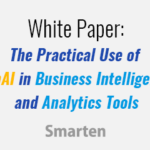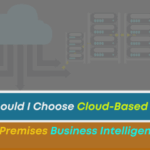Driving Analytics Adoption Through Change Management

Organizations across industries are racing to harness analytics, yet adoption rarely moves in a straight line. Why do some teams take off while others struggle, even when they have the same tools? Many executives assume it’s about picking the right platform or embedding the right algorithms and dashboards, but from my experience, it’s never that simple. Real adoption is about guiding culture, behavior, and how people actually work day to day.
Often, the real barrier isn’t the technology or the skill; it’s that people don’t find real value in what’s been given to them. When analytics content is built and shared by IT teams or ISV partners, it doesn’t always speak to the real, day-to-day questions that business users have. Every user has their own challenges, struggles, and curiosity about the data. The only way to truly help them is by giving them self-serve augmented analytics, tools that let them explore data, test ideas, try quick prototypes, and create, share, and use insights with their teams. That’s what CDS transformation is all about.
When adoption slows, it’s rarely because people lack skill. More often, it’s because they don’t fully trust the data, feel unsure about changing old habits, or find it hard to act on insights or they do not find answers to their questions from the analytics content or datasets rolled out to them. The real change happens when users can explore their own data, try ideas, and share what they learn with their teams. That’s when curiosity turns into real confidence. Trust grows stronger when governance is balanced with flexibility, and when leaders encourage using data to make decisions every day. Adoption isn’t a one-time project; it’s a living journey, driven by trust, curiosity, collaboration, and self-serve analytics. In this article, I share my reflections from that journey, the challenges faced, what helped, and the lessons that stick.
Defining Analytics Adoption Beyond Tools
From what I’ve seen, adoption is much more than turning dashboards on. It starts with seamless integration; analytics should feel like a natural part of the decisions people make every day, not a separate screen. It also depends on trust and transparency, so people believe the numbers and understand where they come from. And it needs widespread literacy, so even non-technical people can use data meaningfully.
Adoption grows step by step, moving from simple descriptive dashboards to predictive and prescriptive insights. And it only works when it becomes part of the culture, when using data is a habit, not just a project. For ISVs, the challenge is bigger: their customers must not just use analytics, but see it as part of the product’s value. This two-layer adoption makes change management harder, but also more important.
The Change Management Barriers That Persist
Across industries and geographies, a few persistent barriers appear when driving analytics adoption.
- Eroded Trust in Data: Past inconsistencies create skepticism. A single error can undo months of effort.
- Cultural Resistance: Hierarchies, intuition-driven decisions, and “the way we’ve always done it” dominate.
- Analytics Overload: Users see analytics as one more application competing for attention.
- Limited Data Literacy: Even when reports are available, the ability to interpret them is uneven.
- Incentives Out of Sync: If leaders are rewarded for outcomes without regard to data use, behavior remains unchanged.
- Mismatch in Expectations: ISVs may assume embedding analytics suffices, while customers expect education, tailoring, and ongoing support.
These are not technical failures; they are human and organizational. Which means they demand leadership more than engineering.
Lessons From the Road: What Enables Real Adoption
1. Leadership That Models Behavior
Analytics adoption begins at the top. When leaders consistently ask, “What does the data show?” They signal that analytics is not optional. Visible sponsorship from leadership teams to partner organizations has proven more effective than any mandate. ISVs who model data-driven decisions internally find it easier to persuade customers to do the same.
2. Designing for Early Wins
Big analytics programs often fail because they try to do too much at once. A better way is to take it step by step: start with a few high-value, simple use cases. Show results that people can see, relate to, and use in real decisions. Those early wins turn into stories, and stories get adoption moving far faster than any slide deck ever could.
3. Building Literacy, Not Just Training
Change management in analytics requires cultivating literacy at every level. This is not a technical boot camp but a sustained journey:
- Explaining the “why” behind analytics.
- Encouraging curiosity and exploration through self-serve features.
- Creating citizen data scientists who extend the reach of central teams.
In ISV contexts, literacy extends to customer ecosystems, where frontline users need confidence to interact with embedded analytics without fear of “breaking something.”
4. Embedding Into Natural Workflows
The closer analytics sit to the moment of decision, the higher the adoption. The focus has been on embedding augmented analytics directly into partner applications, offering clickless search, natural-language queries, and contextual dashboards. When analytics is part of the workflow rather than an additional step, resistance declines sharply.
5. Governance and Transparency
Trust is the currency of adoption. Data lineage, definition clarity, and explainable models are not optional. Governance frameworks ensure that analytics does not become a black box. Emphasis on transparency, such as Key Influencer Analytics, has been central to gaining user trust and countering skepticism.
6. Aligning Incentives With Behavior
Change won’t really stick unless people are rewarded for it. Adoption picks up speed when performance reviews, KPIs, or recognition clearly value data-driven decisions. ISVs can do the same by setting success metrics that don’t just focus on license sales but also measure how consistently their customers use analytics.
7. Iteration and Patience
Perhaps the most under-appreciated lesson: adoption takes time. Cultures rarely flip overnight. An iterative scaling pilot, feedback, refinement, and broader rollout are more effective than attempting a “big bang.” The journey of analytics adoption, and that of many partners, has been marked by patience, humility, and continuous improvement.
Conclusion
The journey to analytics adoption is less about technology and more about people. Too often, organizations underestimate how much culture, habits, and trust influence change. From my experience working with ISV partners, real success comes when adoption is treated as a careful, ongoing process: aligning leadership, building data literacy, embedding analytics naturally into daily workflows, and keeping trust alive at every level.
Across industries and regions, one thing is clear: analytics isn’t just a platform you invest in; it’s a cultural journey. Are we asking the right questions? Are we curious, patient, and empathetic as we lead this change? Those who do will see adoption not just happen but truly take root and thrive.
Ready to move beyond dashboards? Let’s craft a roadmap where analytics is lived, central to every decision and process, and with its deep expertise in augmented analytics, Smarten makes insights actionable and central to every outcome.
FAQs
1. Why is analytics adoption especially challenging in some markets?
Cultural hierarchies and historical reliance on intuition make shifts slower. Change management must be highly contextual, emphasizing trust and visible leadership commitment.
2. How can ISVs embedding Smarten differentiate themselves in driving customer adoption?
By going beyond technology integration. Providing onboarding, literacy support, and governance frameworks positions them as trusted partners, not just vendors.
3. What role does data quality play in adoption?
It is foundational. Even advanced analytics will fail if data quality is questioned. Transparent governance and visible ownership are essential to prevent distrust from spreading.
4. How do you sustain adoption once the initial excitement fades?
Through continuous storytelling of impact, aligning incentives, and evolving features to remain relevant. Adoption is less about launch and more about sustained reinforcement.












